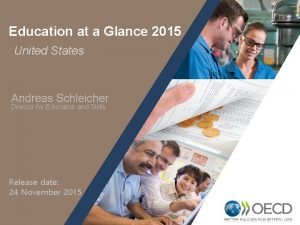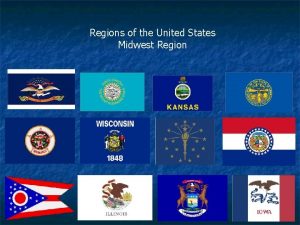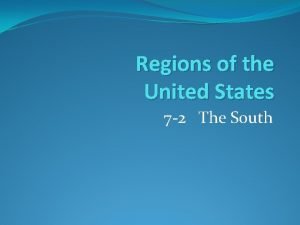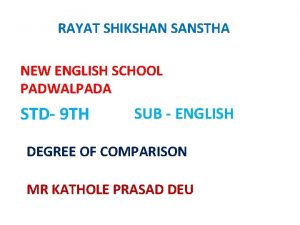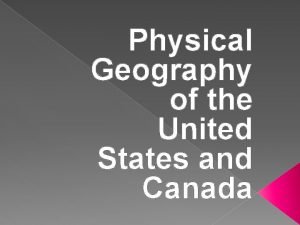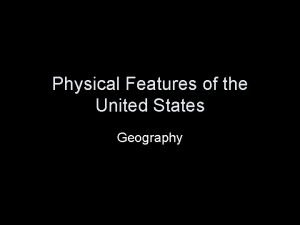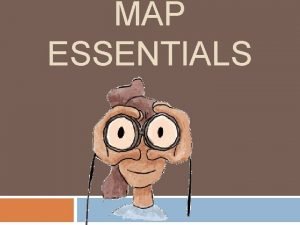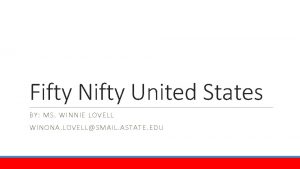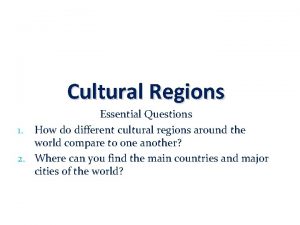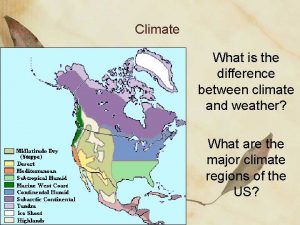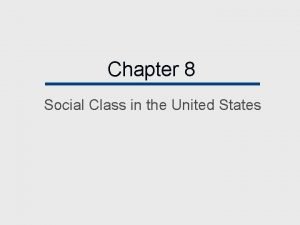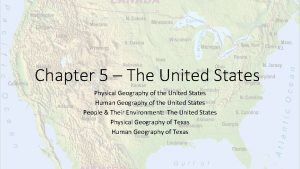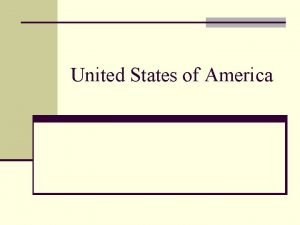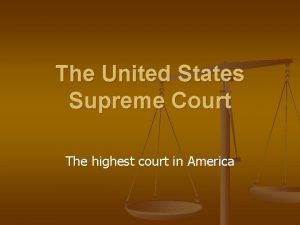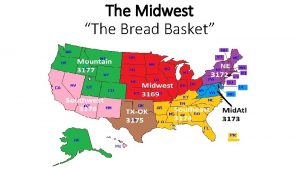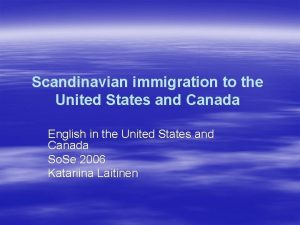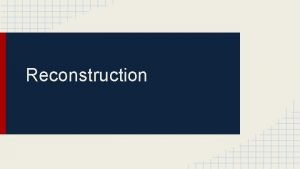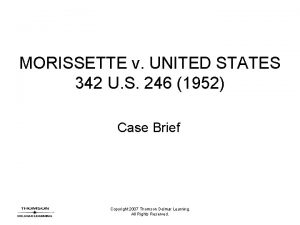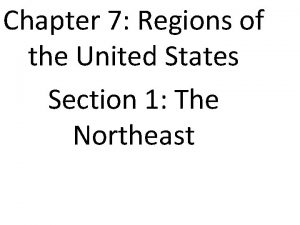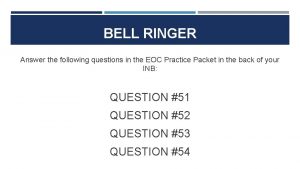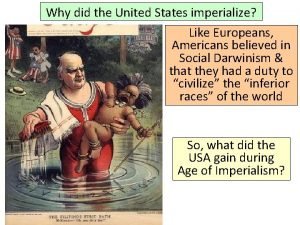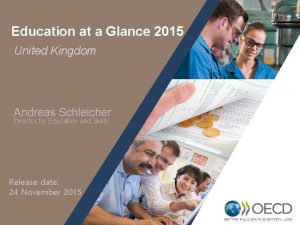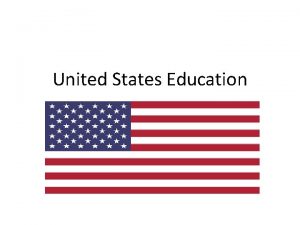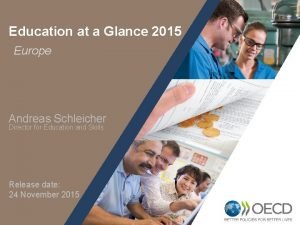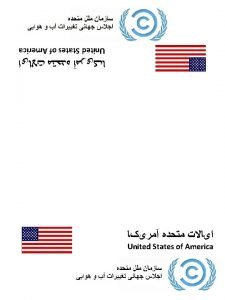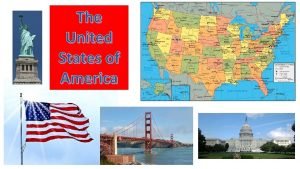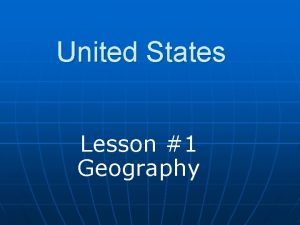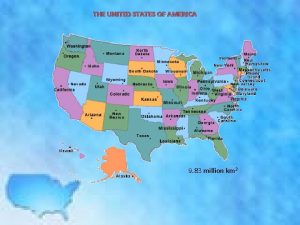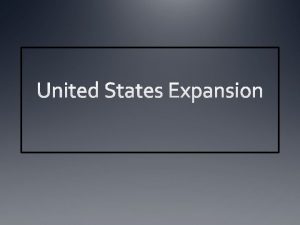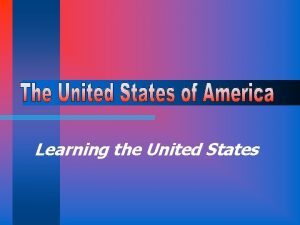Education at a Glance 2015 United States Andreas















































- Slides: 47

Education at a Glance 2015 United States Andreas Schleicher Director for Education and Skills Release date: 24 November 2015 1

Early learning

100 0 % Israel France Belgium United Kingdom New Zealand Iceland Spain Norway Italy Sweden Germany Denmark Korea Estonia Slovenia Netherlands Latvia Japan EU 21 average Portugal Hungary Russian Federation OECD average Luxembourg Finland Slovak Republic Austria Czech Republic Poland Ireland Chile United States Mexico Australia Indonesia Colombia Brazil Turkey Switzerland Saudi Arabia Some 70 % of 3 -year-olds are enrolled in pre-primary education Chart C 2. 1. Enrolment rates at age 3 and 4 in early childhood education (2013) Enrolment rates at age 4 (ISC 02 +ISC 1) Enrolment rates at age 3 in early childhood educational programmes (ISC 01) 90 80 70 60 50 40 30 20 10

C M hil ex e C ico h In Fra ina d n C one ce ol s om ia Tu bi rk a e Po. Bra y z N Prtug il G ethe ola al 20 r n l d Sw av and itz era s e g Be rla e lg nd Ja ium p C ze Sp an ch a R Kor in ep e ub a O EC La lic D Au tvia a s EU ve tria ra Sl 2 g ov 1 ak av Ita e U R er ly ni e ag te pu e d b S lic G tate r N eec s Lu H orw e xe un ay m ga b ry R Un Fi our us it G nl g si ed er an an K m d Fe ing an de do y Sl rat m ov ion N ew Es en i Ze ton a i Swala a e nd Ic de el n an d Child staff ratios in pre-primary education Chart C 2. 2 30 25 20 15 10 5 0

Expenditure on pre-primary education accounts for 0. 6% of GDP, on average Chart C 2. 4. Expenditure on pre-primary educational institutions (2012) Private expenditure on educational institutions in percentage of GDP Public expenditure on educational institutions in percentage of GDP 1. 2 1 0. 8 0. 6 0. 4 Indonesia South Africa Australia Switzerland Japan Korea Netherlands Italy United States Austria United Kingdom Slovak Republic Czech Republic Germany New Zealand OECD average Portugal Spain Luxembourg EU 21 average Belgium Hungary Israel France Poland Latvia Slovenia Finland Iceland 0 Norway 0. 2

Teachers and teaching

Expenditure per primary, secondary and post-secondary nontertiary student increased by at least 10% in most countries between 2005 and 2012 Chart B 1. 4. P, S, PS Annual expenditure per student by educational institutions in 2012 related to change since 2005. Primary, secondary, and post-secondary non-tertiary education Annual expenditure per student (2012, USD) CHE NOR USA ITA ISL UKM FRA SWE NLD CAN JPN ESP BEL SVN FIN IRE AUS KOR POL POR EST HUN CZE ISR RUS SVK CHL MEX TUR Change in expenditure per student between 2005 and 2012 (%)

0 Netherlands Belgium (Fr. ) Latvia Estonia Russian Federation Luxembourg Slovak Republic United Kingdom Finland Slovenia Iceland Hungary Lower secondary education Austria EU 21 average Czech Republic Italy Greece Poland Portugal OECD average Australia Germany France Spain United States Mexico Brazil Turkey Israel Colombia Chile Indonesia Japan Korea China Above-average primary class size but below-average secondary class sizes Chart D 2. 1. Average class size in educational institutions, by level of education (2013) Primary education 60 50 40 30 20 10

Public-school teachers teach between 772 hours per year at the primary level to 643 hours at the upper secondary level, on average Chart D 4. 2. Number of teaching hours per year, by level of education (2013). Net statutory contact time in public institutions Upper secondary, general programmes Primary Hours per year 1 600 1 400 1 200 1 000 800 600 400 0 Colombia Chile Latvia Scotland Mexico Australia New Zealand Netherlands England Canada Luxembourg Ireland Germany Spain France OECD average EU 21 average Belgium (Fl. ) Slovak Republic Italy Portugal Belgium (Fr. ) Hungary Czech Republic Austria Slovenia Israel Estonia Poland Finland Korea Iceland Norway Japan Turkey Russian Federation Greece Denmark United States 200

Teaching time as a share of working time Chart D 4. 3. Net teaching time that lower secondary teachers spend teaching as a percentage of total statutory working time (2013) 80% 60% 40% C Turkey Japan Hungary Austria Iceland Czech Republic Korea Poland Norway Denmark Estonia France Slovak Republic Germany Netherlands Latvia Portugal Spain United States Chile England Scotland Israel 0% Colombia 20%

In many countries, larger classes leave more time for other professional activities, not so in the UK Chart Box D 2. a. 1 Percentage of time spent teaching and learning Relationship between average class size and time spent teaching/learning in lower secondary education (2013). The size of each bubble represents the proportion of lower secondary teachers who reported having more than 10% of students with behaviour problems in their classes Russian Federation 85 Latvia Estonia Czech Republic Poland Finland 80 Slovak Republic OECD average Italy Australia Iceland 75 Portugal Spain France Japan Korea Israel Mexico Chile R 2 = 0. 4235 70 Brazil 65 14 19 24 29 Average class size in lower secondary education 34

In only two countries are teachers' salaries higher than the salaries of comparably educated workers Chart D 3. 1. Teachers' salaries relative to earnings for similarly educated workers or workers with tertiary education (2013). Lower secondary teachers teaching general programmes in public institutions Similarlyeducated workers 1 Workers with tertiary education Italy United States Sweden Estonia Netherlands Poland OECD average Austria Luxembourg Czech Republic Slovak Republic Chile Hungary Norway OECD average Finland England Scotland Australia Belgium (Fr. ) Greece Belgium (Fl. ) Israel France Denmark 0 Slovenia R a t i o 0. 5

New lower secondary teachers with the typical qualifications earn, on average, USD 31 013. At the top of scale and maximum qualifications they earn, on average, USD 53 786 Annual statutory salaries of lower secondary teachers in public institutions, in equivalent USD converted using PPPs at different points in their careers (2013)

Between 2005 and 2013, teachers’ salaries increased in some and decreased in other countries Chart D 3. 3. Index of change between 2000 and 2013 (2005 = 100, constant prices), for teachers with 15 years of experience and typical qualifications 140 130 120 110 100 90 80 70 Latvia Hungary Greece Portugal England Iceland Scotland Spain Japan Italy France Korea Slovenia Austria OECD average Finland Denmark Belgium (Fl. ) Belgium (Fr. ) Sweden 1 Germany Ireland Mexico United States Australia Turkey Luxembourg Norway Israel Poland 50 Estonia 60

Between 2000 and 2013, teachers’ salaries increased overall in real terms in most countries with available data Chart D 3. 3. Index of change between 2000 and 2013 (2005 = 100, constant prices), for teachers with 15 years of experience and typical qualifications 2013 2000 140 130 120 110 100 90 80 70 Latvia Hungary Greece Portugal England Iceland Scotland Spain Japan Italy France Korea Slovenia Austria OECD average Finland Denmark Belgium (Fl. ) Belgium (Fr. ) Sweden 1 Germany Ireland Mexico United States Australia Turkey Luxembourg Norway Israel Poland 50 Estonia 60

Schools were better equipped with new technologies in 2012 than in 2003 Chart D 8. 2 Change between 2003 and 2012 in the index of quality of schools' educational resources (e. g. textbooks, computers for instruction, computer software). Dark blue bars indicate differences that are statistically significant. Mean index difference 1. 5 1. 3 1. 1 0. 9 0. 7 0. 5 0. 3 0. 1 -0. 3 -0. 7 Turkey Poland Uruguay Russian Federation Latvia Macao-China Japan Brazil Canada Slovak Republic Portugal Norway Ireland Czech Republic Greece Spain Belgium Hungary Hong Kong-China Australia Sweden OECD average 2003 Switzerland Indonesia Liechtenstein Germany Italy New Zealand Denmark Finland Austria Thailand United States Luxembourg Netherlands Mexico Iceland Korea Tunisia -0. 5

Teachers’ skills and readiness to use information and communication technologies (ICT) for problem solving (2012) Chart D 5. 4 % 100 Group 4 (Good ICT and problem-solving skills) 90 80 Group 3 (Moderate ICT and problemsolving skills) 70 60 Group 2 (Failed ICT core stage 1 or minimal problem-solving skills) 50 40 Group 1 (Opted out of the computerbased assessment) 30 20 10 Group 0 (No computer experience) Poland Estonia Russian Federation* Ireland Slovak Republic Austria Denmark Flanders (Belgium) Average Germany United States Norway Canada Japan Netherlands Sweden Czech Republic England/N. Ireland (UK) Korea 0

Relationship between teachers’ use of ICT skills at work and proficiency in those skills (2012) Chart D 5. 4 2. 6 Korea 2. 4 Index of use of ICT skills at work United States 2. 2 England/N. Ireland (UK) Estonia 2. 0 Canada Netherlands 1. 8 Sweden Czech Republic Average Russian Federation* Slovak Republic Flanders (Belgium) Norway Denmark Poland Germany Austria 1. 6 Japan Ireland 1. 4 R 2 = 0. 3951 1. 2 1. 0 20 25 30 35 40 45 50 55 Proportion of teachers with good ICT and problem-solving skills 60 65 70

Students who use computers at school only moderately score the highest in reading Score points Relationship between students’ skills in reading and computer use at school (average across OECD countries) 520 Highest score 510 Students a value above 1 use Most students with a valuewith above 0 chat or emailonce at least use email at school at least a once a week at school, browse month, browse the Internet for Digital reading schoolwork at least schoolwork almost once a week, andevery day, and practice and drill(e. g. on computers (e. g. practice and drill on computers for foreign language or maths) at least once a month least weekly 500 490 480 470 460 450 -, 2 -, 1 , 0 OECD average Source: Figure 6. 5 , 1 Index of ICT use at school , 2

Students who do not use computers in maths lessons score highest in mathematics Score points Relationship between students’ skills in reading and computer use at school (average across OECD countries) 520 Paper-based mathematics Highest score 510 500 490 Computer-based mathematics 480 470 460 450 -, 2 -, 1 , 0 OECD average Source: Figure 6. 7 , 1 , 2 Index of computer use in mathematics less

0 Malaysia Italy Georgia Iceland Brazil Japan Sweden France Korea Israel Estonia Mexico Bulgaria Croatia Serbia Latvia Denmark Slovak Republic Romania OECD average Norway Finland Russian Federation New-Zealand Netherlands Czech Republic Spain Australia Chile Cyprus Singapore Poland Belgium (Flanders) Abu Dhabi (UAE) Portugal United States England Almost one in five teachers in OECD countries feels a need for further training in how to use ICT in the classroom Chart D 8. 4 Percentage of lower secondary education teachers who report having a high level of need for professional development to improve their ICT skills for teaching % 50 45 40 35 30 25 20 15 10 5

Tertiary education

% 70 0 South Africa Indonesia Brazil China Costa Rica Italy Mexico Turkey Saudi Arabia Chile Colombia Germany Slovak Republic Czech Republic Portugal Hungary Slovenia Austria Greece EU 21 average Latvia Finland New Zealand Estonia Iceland OECD average Spain Denmark Poland France Belgium Netherlands United States Sweden Switzerland Israel Australia Norway United Kingdom Ireland Lithuania Luxembourg Canada Russian Federation Korea More people have benefited from education than ever before Chart A 1. 2. Percentage of younger and older tertiary-educated adults (2014) Proportion of the 25 -34 year-old population with tertiary education Proportion of the 55 -64 year-old population with tertiary education 60 50 40 30 20 10

More than 40% of students who graduated with a doctorate earned it in either science or engineering Chart A 3. 4. Percentage of students who graduate from sciences and engineering at doctoral level (2013) Sciences Engineering, Manufacturing & Construction 80 % Sciences and Engineering, Manufacturing & Construction (international students) 70 60 50 40 30 20 0 France Chile Canada Luxembourg Israel Sweden Estonia Czech Republic Colombia Austria Belgium United Kingdom New Zealand Italy EU 21 average Spain Ireland OECD average Germany Denmark Portugal Switzerland Norway Finland United States Slovak Republic Russian Federation Slovenia Latvia Greece Australia Korea Japan South Africa Hungary Netherlands Mexico Turkey 10

More than 30% of adults are more educated than their parents Chart A 4. 1. Intergenerational mobility in education (2012) Downward mobility (lower educational attainment than the highest level reached by parents) Upward mobility to upper secondary or post-secondary non-tertiary education Upward mobility to tertiary education % 100 90 80 70 60 50 16 40 30 10 20 Austria Germany Czech Republic United States Sweden Italy Slovak Republic Norway Australia Estonia Denmark Flanders (Belgium) Netherlands Japan Canada France England/N. Ireland (UK) Spain Ireland Finland Poland Russian Federation Korea 0 Average 22 10

Annual spending per tertiary student ranges from USD 2 089 to USD 32 876 Chart B 1. 2. T Annual expenditure per student by educational institutions for all services, by level of education (2012). Tertiary education 28 000 26 000 24 000 22 000 20 000 18 000 16 000 Indonesia Colombia Latvia Turkey Chile Mexico Korea Italy Czech Republic Brazil South Africa Slovenia Israel Spain New Zealand Ireland France Belgium Austria Australia Japan Germany Finland Netherlands Norway Sweden United Kingdom Switzerland United States 0 Luxembourg 2 000 Estonia 4 000 Hungary 6 000 Iceland 8 000 O IE 8 E x 7 n C p 6 D e n q au d vi evt ra u alr ge en tp e r U Poland 10 000 Slovak Republic 12 000 Portugal 3 2 14 000

Between 2005 and 2012, expenditure per tertiary student increased by 10%, on average Chart B 1. 4. T Annual expenditure per student by educational institutions in 2012 related to change since 2005. Tertiary education Annual expenditure per student (2012, USD) Tertiary education 27 000 OECD average USA 26 000 25 000 CHE 24 000 23 000 SWE 22 000 21 000 NOR 20 000 NLD 19 000 FIN 18 000 AUS JPN 17 000 16 000 BEL IRE OECD average 15 000 FRA 14 000 13 000 ISR ESP 12 000 CZE SVN 11 000 BRA KOR 10 000 POL POR ITA 9 000 R 2 = 0. 065 ISL HUN SVK 8 000 RUS TUR MEX CHL EST 7 000 6 000 -20 -10 0 10 20 30 40 50 60 70 80 Change in expenditure per student between 2005 and 2012 (%)

0 Korea Japan Chile United States Colombia Australia New Zealand Israel Portugal Hungary Canada United Kingdom Russian Federation Latvia Italy Mexico OECD average Netherlands Indonesia Spain Slovak Republic Poland EU 21 average Estonia Czech Republic France Turkey Ireland Germany Slovenia Sweden Belgium Iceland Luxembourg Austria Norway Finland Switzerland Denmark About 30% of spending on tertiary education comes from private sources, on average Chart B 3. 1 Share of private expenditure on educational institutions (2012) % 90 80 70 60 50 40 30 20 10

75% or more students in Australia, New Zealand, Norway, the United Kingdom and the United States benefit from public loans or scholarships/grants Chart B 5. 3 Distribution of scholarships/grants and public loans to students in Bachelor's or equivalent level (2013 -14) benefit from public loans only or from public loans AND scholarships/grants benefit from public loans only benefit from scholarships/grants only benefit from public loans AND scholarships/grants % of students DO NOT benefit from public loans OR scholarships/grants 100 90 80 70 60 50 40 30 20 Switzerland Austria Belgium (Fr. ) Italy Belgium (Fl. ) France Finland Turkey Norway United States New Zealand Australia 0 United Kingdom 10

30 The returns to tertiary education remain strong

45 15 0 Slovak Republic Spain Greece Lithuania Latvia Czech Republic Ireland Poland Hungary EU 21 average Slovenia Italy Portugal Belgium France 1 Sweden OECD average Finland Russian Federation 1 Germany Estonia Austria Canada United States Netherlands Switzerland Turkey Denmark Australia United Kingdom 2 Luxembourg Israel Costa Rica Norway Colombia New Zealand Chile 1 Iceland Brazil 1 Mexico Korea The employment benefit of tertiary education is significant, but not in all countries Below upper secondary Upper secondary or post-secondary non-tertiary Chart A 5. 1. Unemployment rates, by educational attainment (2014) Tertiary 40 35 30 25 20 % 10 5

C hi le B C ra ol z o il H mb un ia g M ary ex Tu ico rk U e C nite Irel y ze d a ch S nd R tate ep s Sl ov S ub ak lov lic R en ep ia u Po blic Po lan rtu d O EC g D Is al Lu av rae EU xe era l 21 mb ge o N ave urg et r h a Sw erl ge itz and er s la Fr nd an Au ce st Ja ria U ni pa te d Sp n Ki a ng in d G om re Fi ece nl a Ko nd re a C Ital an y N B ad ew el a g Ze ium al Es and Au ton s ia D tra en lia m N ark or w ay Adults with a tertiary degree will earn 100% more than those with only below upper secondary education Below upper secondary Chart A 6. 2. a Difference in relative earnings for adults by level of education (upper secondary education=100) Tertiary 300 250 200 150 upper secondary education 100 50 0

The higher the level of education, the higher the relative earnings Chart A 6. 1. Relative earnings of tertiary-educated workers, by level of tertiary education (2013) Bachelor's or equivalent Master's, doctoral or equivalent 300 280 260 240 220 200 180 5 I 4 5 6 0 4 160 140 Chile Brazil Ireland Greece Hungary Austria Portugal United States Israel OECD average United Kingdom Canada EU 21 average Korea Czech Republic Australia France New Zealand Finland Slovak Republic Norway Sweden Italy 100 Denmark 120

Adults completing tertiary education benefit from substantial returns on their investment Chart A 7. 1 Private net financial returns for adults attaining tertiary education (2011) Men Women 600 000 500 000 400 000 300 000 200 000 Korea New Zealand Spain Sweden Denmark Estonia Norway Finland Italy Israel Canada Germany EU 21 average Australia Netherlands OECD average Austria Portugal Slovak Republic Slovenia United Kingdom Czech Republic Hungary Poland United States 0 Chile 100 000

0 -50 000 Korea Sweden Estonia New Zealand Spain Switzerland Canada Slovak Republic Israel Norway Denmark Poland OECD average Chile Men Australia Finland Czech Republic EU 21 average United Kingdom Austria Portugal Italy Netherlands Germany Slovenia Hungary United States Taxpayers benefit significantly too Chart A 7. 3 Public net financial returns for adults attaining tertiary education (2011) Women 300 000 250 000 200 000 150 000 100 000 50 000

The higher the level of skills, the more likely the participation in employer-sponsored education Chart C 6. 1. Participation in employer-sponsored formal and/or non-formal education, by skills and readiness to use information and communication technologies for problem solving (2012) Group 4 (Good ICT and problem-solving skills) Group 3 (Moderate ICT and problem-solving skills) Group 2 (Failed ICT core test or minimal problem-solving skills) % 80 70 60 50 40 30 20 Russian Federation Poland Japan Slovak Republic Austria Korea Flanders (Belgium) Czech Republic Germany Ireland Average Estonia Canada ngland/N. Ireland (UK) Australia Sweden United States Netherlands Finland Norway 0 Denmark 10

37 Internationalisation continues

OECD countries attract 73% of all foreign and international students Distribution of foreign and international students in tertiary education, by country of destination (2013) Other non-OECD countries 20% Other OECD countries 10% United States 19% Turkey 1% Korea 1% Spain 1% Saudi Arabia 2% Netherlands 2% Austria 2% Italy 2% United Kingdom 10% China 2% Canada 3% Japan 3% Russian Federation 3% Germany 5% Australia 6% France 6% Chart C 4. 3.

ni U bo Au urg te s d tra Ki lia Sw ngd itz om er la N A nd ew us Z tri N ea a et la he nd rla D nd en s m Be ark lg iu Fr m an C ce an a Fi da n G lan er d m a Ic ny el an Ire d la Sw nd ed Sl ov Hu en ak ng R ary ep ub U Po lic ni rtu te d ga St l at e La s t N via or w a Ja y p Es an to ni a Sp Sl ain ov en Po ia la nd C h M ile ex ic o em Lu x International enrolment in relative terms % Total tertiary education Chart C 4. 1. International or foreign student enrolments as a percentage of total tertiary education OECD Average 50 45 40 35 30 25 20 OECD Average 15 10 5 0

Students from Asia form the largest group of international students Distribution of foreign and international students in tertiary education, by region of origin (2013) Not specified 5% Oceania 1% North America 3% Asia 53% Latin America and the Caribbean 5% Africa 8% Europe 25% Chart C 4. 4.

Gender differences

% 0 Korea Canada Russian Federation Norway Luxembourg Ireland Israel Australia Sweden Poland Latvia United Kingdom Belgium United States Denmark Estonia Slovenia Netherlands France Finland Spain Iceland OECD average EU 21 average Switzerland New Zealand Greece Austria Portugal Hungary Slovak Republic Czech Republic Saudi Arabia Japan Colombia Italy Germany Chile Mexico Turkey Costa Rica Brazil Indonesia South Africa Women are more likely than men to have attained tertiary education Men Chart A 10. 1 Percentage of 25 -34 year-olds who have attained tertiary education, by gender (2014) Women 80 70 60 50 40 30 20 10

0 Japan Turkey Switzerland Germany China Indonesia Mexico Chile United Kingdom Luxembourg Netherlands United States OECD average Bachelor’s or equivalent Colombia Spain Australia Russian Federation Israel Italy Finland EU 21 average Austria Belgium Canada Denmark Saudi Arabia Portugal South Africa Hungary New Zealand Slovenia Czech Republic Slovak Republic Norway Latvia 80 Sweden There is a large difference between the shares of women with bachelor's and doctoral degrees Chart A 3. 3. Percentage of female graduates in tertiary levels of education (2013) Doctorate or equivalent % 70 60 50 40 30 20 10

The public benefit for a man attaining tertiary education is higher than that for a woman Chart A 7. 3 Public net financial returns for adults attaining tertiary education (2011) Men Women 300 000 250 000 200 000 150 000 100 000 Korea Sweden Estonia New Zealand Spain Switzerland Canada Slovak Republic Israel Norway Denmark Poland OECD average Chile Australia Finland Czech Republic EU 21 average United Kingdom Austria Portugal Italy Netherlands Germany Slovenia -50 000 Hungary 0 United States 50 000

20 0 Indonesia Brazil Colombia Mexico Chile Costa Rica Israel Greece Turkey Slovak Republic Sweden Iceland Lithuania Croatia Hungary France Portugal United States Luxembourg Italy Norway OECD average Russian Federation New Zealand Belgium Slovenia Spain Austria Latvia United Kingdom Australia Czech Republic Denmark Germany Netherlands Switzerland Ireland Poland Canada Finland Japan Korea Estonia Boys tend to perform worse in school than girls Girls Chart A 10. 2 Gender differences in the percentage of 15 year-olds students who are low achievers in all subjects (e. g. mathematics, reading, science) (PISA 2012) Boys 60 50 40 30 % 10

The highest proportion of female teachers are concentrated in the earlier years of schooling and shrink at each successive level of education Chart D 5. 3 Percentage of women among teaching staff in public and private institutions, by level of education (2013) % Lower secondary education Upper secondary education Pre-primary education All Tertiary education Primary education 100 90 80 70 60 50 40 30 20 0 Latvia Russian Federation Estonia Iceland Israel Slovenia Italy Hungary Sweden Slovak Republic Norway Czech Republic Poland Finland Austria Portugal Denmark Brazil EU 21 average Korea Chile OECD average United States Greece Germany New Zealand France Belgium United Kingdom Spain Luxembourg Colombia Switzerland Indonesia Mexico Turkey China Netherlands Japan Canada Ireland 10

Education at a Glance 2015 http: //www. oecd. org/education-at-a-glance-19991487. htm www. oecd. org/edu Andreas. Schleicher@oecd. org Follow us on: @OECDEdu. Skills @Edu. Skills OECD @ Edu. Skills OECD
 Education at a glance 2015
Education at a glance 2015 Was the united states on the axis powers or allied powers?
Was the united states on the axis powers or allied powers? Unit 2 the united states and canada
Unit 2 the united states and canada Sectionalism map of the united states
Sectionalism map of the united states Us pro soccer
Us pro soccer Marshall case
Marshall case United states student association
United states student association The united states ought to provide a universal basic income
The united states ought to provide a universal basic income Us constitution preamble
Us constitution preamble The united states in the caribbean 1776-1985
The united states in the caribbean 1776-1985 What is the southeast region of the united states
What is the southeast region of the united states Expansion of the united states of america 1607 to 1853 map
Expansion of the united states of america 1607 to 1853 map Who was nicholas novikov? when did he write this telegram?
Who was nicholas novikov? when did he write this telegram? Who was the previous owner of the spanish cession
Who was the previous owner of the spanish cession Awake the united states
Awake the united states Mapp v ohio
Mapp v ohio We have pacified some thousands of the islanders
We have pacified some thousands of the islanders Chapter 6 lesson 2
Chapter 6 lesson 2 Midwest region of the united states
Midwest region of the united states 7 regions of the united states
7 regions of the united states The united states is the greatest buyer positive degree
The united states is the greatest buyer positive degree United states and canada physical map
United states and canada physical map Physical feature map of the united states
Physical feature map of the united states Earth latitude map
Earth latitude map Fifty united states
Fifty united states Chapter 2 free enterprise in the united states
Chapter 2 free enterprise in the united states North central america
North central america Who created clowns
Who created clowns Subtropical united states
Subtropical united states What are the social classes in the united states
What are the social classes in the united states Physical geography of the united states
Physical geography of the united states Ibn-tamas v. united states
Ibn-tamas v. united states Mr.pirzada
Mr.pirzada United states government: principles in practice answers
United states government: principles in practice answers Geographical position of the usa
Geographical position of the usa United states lactation consultant association
United states lactation consultant association Gideon v wainwright significance
Gideon v wainwright significance Mississippi physical features
Mississippi physical features The midwest facts
The midwest facts Immigration to the united states
Immigration to the united states United states v. cruikshank apush
United states v. cruikshank apush Morissette v. us
Morissette v. us Us land acquisition map
Us land acquisition map Judicial branch
Judicial branch Fifty nifty united states from 13 original colonies
Fifty nifty united states from 13 original colonies Yosemite sam confederate
Yosemite sam confederate How did these events affect the united states
How did these events affect the united states Why did the united states imperialize
Why did the united states imperialize
